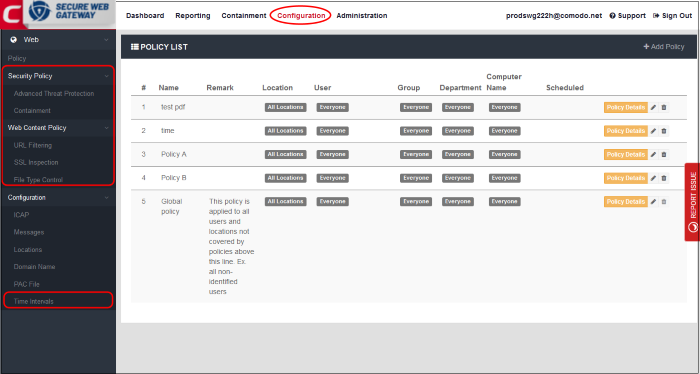Manage Policies
- Click 'Configuration' > 'Policy'
- Policies let you apply specific web-filtering and threat-prevention rules to trusted locations.
- You need to configure policy targets and components before you configure a policy.
- Targets - Users/locations/departments.
- Components – Components are security policy, web-content policy and schedule.
-
Click 'Add Policy' to open the new policy wizard. The interface has three tabs:
- Click 'Add Policy' to open the new policy wizard. The interface has three tabs:
- Name – Select the priority of the policy and create a policy label. Policies are prioritized top-to-bottom according to this list. In the event of a conflict between policies, Comodo Secure Web Gateway (SWG) will implement the setting in the policy nearer the top of this list. You can change the priority of a policy by clicking 'Edit' > 'Policy Order'
- Select Objects – These are the targets of the policy. The targets can be any combination of locations, users, user-groups, departments or computers.
- Click 'Configuration' > 'Locations' to add and manage locations (trusted networks)
- Click 'Administration' > 'User Management' to add/manage users, user-groups, departments and computers
- Apply Policy – This is where you add the policy components from the 'Security Policy', 'Web Content Policy' areas and 'Time Intervals' shown in the left-menu:
Security Policy components
- Advanced Threat Protection - Comodo Secure Web Gateway ships with a default security policy to block all web threats. You can create exceptions to advanced threat protection which will be applied to your policy. See 'Configure Advanced Threat Protection Settings' for more information.
- Containment - All unknown applications and processes are automatically run in a secure, virtual environment on a user's endpoint. The 'containment' component lets you define what type of files should be contained. You can also specify the maximum size and depth of archive files which Comodo SWG should attempt to scan. See 'Configure Containerization Settings' for more information.
Web Content Policy components
- URL Filtering - Configure which website categories should be allowed or blocked. You can also create your own domain whitelist or blacklist. See 'Manage URL Filtering Policies' for more information.
- SSL Inspection - Configure whether or not Comodo SWG should check that websites use an SSL certificate from a trusted certificate authority. You can also download and install the Comodo SWG root certificate, which is required if you wish to decrypt and scan files from https sites. See 'Configure SSL Inspection Setting' for more details.
- File Type Control - Configure which file types Comodo SWG should prevent users from downloading. You can fine-tune this restriction by website category. See 'Manage File Type Control Rules' for more information.
Time Interval (Policy schedule time)
- Time Interval - Set the times that the policy is active. You can create a schedule in 'Configuration' > 'Time Intervals'. You can then add the schedule to a policy. See 'Configure Policy-Time-Schedules' for more information.
- You can create and apply your policy after configuring your targets and policy components. See 'Apply Policies to Networks' for more details.
- The policy component interfaces are shown in the red box in the screenshot below:

Click on the following links for more details:



